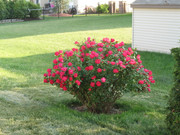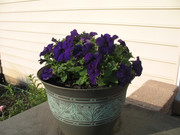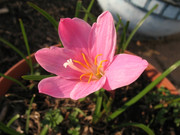Either rabbit populations are very high this year (and they don't seem to be) or they particularly like eating Dreamland zinnia. In either case, none of mine in the back are growing all that well because they keep being eaten back to the stem.
OK, enough of that. When this happens, there are a few things you can try:
1) Fence the garden, if possible. Fencing should go down at least six inches below ground as rabbits are excellent diggers. This isn't a good solution for me as these are display flower gardens.
2) Trim your roses, use a machete or any other device to chop the thorny branches into small pieces, and scatter them in the areas where you have rabbit problems. Rabbits won't pick their way across thorns any more than you would. This is most useful in smaller areas, and isn't particularly attractive. However, if this continues, I'll try it.
3) Chop up anything pungent or hot and scatter it around the plants. I used three small handfuls of black pepper, chopped fairly rough, and scattered it around the zinnia.
4) Spray the plants with a repellant. There are plenty of homemade repellants, most involving a little dish soap, black pepper, cayenne pepper, and fresh garlic. Refresh this after rainfall.
5) Spray the plants with an over the counter repellant, like Liquid Fence. The effectiveness is variable, and it tends to be a bit on the spendy side.
6) Plant sacrificial plants at the edge of your garden for the rabbits to eat in the hope that they won't go after the others. It's not terribly effective and can attract rabbits to the edible plant(s).
7) Ignore it.
Tuesday, June 11, 2013
A Bunny Bonanza
Saturday, June 1, 2013
That Lawn Thingy
If you noticed the previous series of photos, the lawn looks...very odd. For some reason, all the tips have gone brown, but the dead tips don't extend past about an eighth of an inch. Underneath that, the grass is green and growing.
This is actually a statement on what NOT to do with your lawn. Don't mow the day before an unseasonable frost. Then don't follow it up with a mow the day before the temperatures suddenly spike to a very unseasonable 92.
If you do, expect this to happen. While you can apply copious water to force further growth and then cut off the dead tips, I'm content to let nature take its course. The next time I mow, the grass will restore itself to the normal color and texture, with no harm done. It's best to wait until after a good rainfall and a resumption of normal temperatures to do this. Fortunately, large amounts of rain are expected tomorrow and Monday, followed by a much more normal early June.
The June Gardens
Early June, but June nonetheless! Garden development has been slow until the last few days when the weather suddenly warmed up. At the moment, I'd say they're about two weeks behind the average, but they're coming along.
As always, you can click on any photo to embiggen it.
The rose bloomed a bit late, but made up for lost time by blooming particularly spectacularly:

The petunia pots on the pedestals tend to do well, but that's a hot, and very sunny, environment. I chose a deep purple this year:

The rain lilies are severely delayed, and seem weak this year. The pots took ages to return. Still, they're starting to bloom:

The red zinnia are finally starting to bloom, but they're also very small and slow:

The overall garden shot is much different than the initial one, but it still looks very underdeveloped to my eye. The late frost we had definitely cost time on the zinnia and other hot-weather plants, and it'll take some time and some work for those to catch up:
